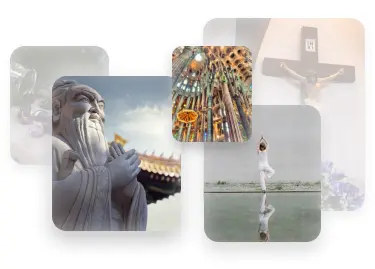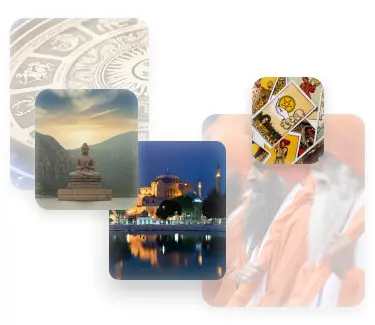Presumably XXVII century BCE.
Oracles
Oracles are the most common ways of predicting the future in all spheres of life. In general, it is an appeal for answers or guidance to some deity or entity. There are dedicated oracles for various subjects.
The section is open for editing
When creating the article, materials
from the book were used: Oparina A.A. Wheel in Wheel. Archaeological study of the Book of the Prophet Ezekiel
The whole world
Unknown
A brief history
If we consider the priests who performed the function of an oracle, predicting the future on behalf of a deity as a starting point, then probably the the tradition of addressing oracles began in the Ancient Kingdom of Egypt around XXVII century BCE.
The concept of an oracle appeared much later in ancient Greece and is closely related to the Temple of Apollo. In the VII — VI centuries BCE Delphi began to play the role of the main Greek sanctuary. The Oracle of Delphi had a high authority in the Greek world, making decisions in the political and religious spheres.
In a study entitled “A Wheel in a Wheel” A.A. Oparin writes about the Lydian king Croesus the following:
“To do this, Croesus immediately began to test oracles in Hellas and Libya, sending ambassadors to different places. He sent some to Delphi, others to Aby in Phocis, others to Dodona; others were also sent to Amphiarai and to Trophonius, and finally to Branchis in the Milesian region. These were Hellenic soothsayers, where Croesus sent oracles to question. However, he also sent envoys to the oracle of Ammon in Libya.” However, Croesus did not just send ambassadors to various oracles. He, together with his messengers, sent the richest gifts to temples with oracle, whom he questioned. By doing this, he wanted to bribe, propitiate the gods so that they would give the answer he needed. Croesus lived in a state where money bought love, honor, and life. And so he was sure that money could buy everything, even gods.”
Gradually, the priesthood was supplanted by the clergy, remaining only among the primitive tribes of Africa, South America and Oceania.
But the desire to look into the future has not disappeared and gradually began to yield different ways to attempt it, among them a ball of predictions and different decks, solitaire, thread with a needle, a coin toss and other methods, either with the participation of third parties in the person of shamans, fortune tellers, clairvoyants or without them.
The essence
Oracles were perceived as a link between gods and people, allowing them to ask questions directly to the deities.
Most Greek oracles were dedicated to the god Apollo and were called Apollonian or often ecstatic (due to the traditional falling of the priests of the Temple of Apollo into a trance). Temples of oracles were in Delphi, Delos, Athens, Thebes, Boeotia, Argos and many other cities. The most famous was the temple of the Oracle of Delphi, located near the two Phaedriades rocks at the foot of Mount Parnassus. In the most sacred room of the temple, called the aditon, inhaling noxious fumes from cracks in the bedrock, the priestess referred to as Pythia, gave predictions. The Pythia, sitting on a sacred tripod in the state of sacred ecstasy, verbally and randomly answered the questions posed. Special priests composed hexameter verses from those words, which often had ambiguous or vague content.
The oracles of Dodona and Olympia predicted on behalf of Zeus. Unlike Dodona, where the rustling of leaves and the murmur of water were interpreted, in Olympia the answer of God was sought in the shape and color of the entrails of sacrificed animals, and in the process of burning offerings. In Libya, in the oasis of Siwa, the priests interpreted as answers the swaying of the idol of Zeus-Ammon, which was carried during processions by the priests. In the Achaean city of Fara, the oracle was a statue of Hermes. It was believed that the first word heard after voicing a question near the statue was the answer of Hermes himself.
Haruspices in ancient Rome used to tell the fortune from the entrails of animals and various natural phenomena. The cult existed at least until V century CE.
It is known about numerous oracles of Apollo in Asia Minor. A popular Claros priest in a Colophon, elected from a certain clan, drank water from a spring, and in verse form foreshadowed the future, asking only the name and number of petitioners. In the Lycian city of Patara, on the territory of modern Turkey, the priestess was locked up at night in the temple, where she interpreted her dreams.
Biography of the creator/creators
The section is open for additions
Modern Leaders
The section is open for additions
Scandals
The section is open for editing
Rituals
In different temples, the rituals differed, for example, in the sanctuaries of the God Asclepius prophetic dreams called incubations were interpreted. The Oracle of the hero Amphiaraus was especially famous near the city of Orope. Visitors to the oracle had to abstain from drinking wine for three days, perform sacrifices and purification rites. Only then could they enter the temple to receive God’s advice or warning in a dream.
In the sanctuary of Pluto in the city of Acharavi, not the visitors themselves interpreted dreams, but special priests. In the temple of the city of Amphiclia, it was believed that Dionysus sent prophetic dreams to the priests, and then they interpret them in an ecstatic state.
In the oracle of the hero of Trophonius, a special action was played out in the city of Lebadia. The petitioners were previously washed and oiled by 13-year-old boys. The priests brought them to the springs of Oblivion and Memory, so that the petitioner forgot everything that could distract him, but remembered the messages of the Deity. After that, the person was dressed in ritual bandages and shoes and led to an opening on a mountain surrounded by a marble wall. According to legend, an unknown Force took the petitioner to the depths of the Earth, where he was granted visions about his future fate, and then thrusted back to the surface. The priests questioned the newcomer about what they had seen and led him to the sanctuary of the Good Demon and Good Happiness, where he could recover.
In Italy, in the area of the city of Cumae, it was believed that a local oracle summoned the shadows of the dead to question them about the future. According to legend, there was a lake with poisonous fumes, which was considered the entrance to the Kingdom of the Dead. The priests depicted the evoked dead in clouds of vapor and answered the questions posed.
In Greece, there were wandering Sibylline prophetesses who did not give answers to questions, but uttered gloomy prophecies. According to the references that have come down to us, there were anywhere from one to twelve Sibyls. It is known about the Phrygian, Kolonfian, Egyptian and numerous prophetesses. Especially famous was the old Cumaean Sibyl, who, according to the legend, lived for a very long time and wrote down prophecies on a palm leaf, forming peculiar books. The “Sibylline books” themselves eventually acted as a kind of oracles, the Romans opened them in a random place, considering the first text they saw an answer to their question. These records were kept in the temple of Jupiter Capitoline and interpreted at the request of the Roman Senate in times of strife.
The Jewish high priests used the holy artefacts named urim and thummim, addressing the Lord on behalf of the king or the Jewish people. Urim and thummim served as the only authorized oracle. Exact descriptions of these artefacts have not been preserved, but researchers suggest that these were small stones that served as cast lots with affirmative and negative answers. Asking questions, the high priest tossed the stones and interpreted the symbols in the way they fell as a message from God.
In ancient China, especially during the Shang Dynasty, oracles used bones and fire for divination. The oracle addressed the deities with questions about the future weather, harvest, the fate of the petitioner, carving them out on the bones (more often the shoulder blades of bulls) or the shells of turtles. After that, the red-hot iron pin pressed against the bone until it cracked. The resulting cracks were interpreted as hieroglyphs and the answer of the deity.
Holy places
The Temple of Jupiter Capitoline. The cities of Delos, Thebes, Athens, Rome.



 RU
RU
